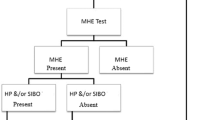Abstract
Background and Aim
Helicobacter pylori (H. pylori) bacteria convert urea to ammonia, which has been implicated in causation of hepatic encephalopathy in patients with liver cirrhosis. The role of H. pylori infection in causation of minimal hepatic encephalopathy (MHE) has not been well studied. We looked at the relationship of H. pylori infection with MHE and hyperammonemia in patients with liver cirrhosis and the effects of anti-H. pylori treatment in patients with MHE and H. pylori infection.
Methods
Patients with liver cirrhosis underwent psychometric tests for detection of MHE, rapid urease test to look for evidence of H. pylori infection and measurement of fasting blood ammonia levels. Patients with MHE were treated with triple-drug anti-H. pylori treatment for one week. Rapid urease test, blood ammonia levels, and psychometric tests were repeated four weeks after treatment.
Results
H. pylori infection was found more often in patients with MHE (63%) than in those without MHE (37%). Blood ammonia levels were significantly higher in patients with MHE than those without. After H. pylori treatment in patients with MHE, blood ammonia levels showed a significant decline and psychometric test results returned towards normal.
Conclusion
In patients with liver cirrhosis, there is a significant association between H. pylori infection and MHE. Anti-H. pylori therapy results in reduction in blood ammonia levels and improvement in MHE.
Similar content being viewed by others
References
Mullen KD, Dasarthy S. Hepatic Encephalopathy. In: Schiff ER, Sorrell MF, Maddrey WC, eds. Schiff’s Disease of the Liver. 8th ed. Philadelphia: Lippincott-Raven; 1990. p. 545–81.
Butterworth RF. Complications of cirrhosis III: Hepatic Encephalopathy. J Hepatol. 2000;32 Suppl 1:171–86.
Quero JC, Schalm SW. Subclinical hepatic encephalopathy. Semin Liver Dis. 1996;16:321–8.
Dhiman RK, Saraswat VA, Verma M, et al. Figure connection test: a universal test for assessment of mental state. J Gastroenterol Hepatol. 1995;10:726–31.
Gubbins GP, Moritz TE, Marsano LS, et al. The Veterans Administration Cooperative Study Group No. 275. Helicobacter pylori is a risk factor for hepatic encephalopathy in acute alcoholic hepatitis: The ammonia hypothesis revised. Am J Gastroenterol. 1993;88:1907–9.
Miyaji H, Ito S, Azuma T, et al. Effect of Helicobacter pylori eradication therapy on hyperammonaemia in patients with liver cirrhosis. Gut. 1997;40:726–30.
Ito S, Miyaji H, Azuma T, et al. Hyperammonaemia and Helicobacter pylori. Lancet. 1995;346:124–5.
Quero JC, Hartmann IJC, De Rooij F, et al. Hyperammonamia and Helicobacter pylori. Lancet. 1995;346:713–4.
Plevris JN, Morgenstern R, Hayes PC, Bouchier IAD. Hyperammonaemia in cirrhosis and Helicobacter pylori infection. Lancet. 1995;346:1104.
Mousseau DD, Butterworth RF. Current theories on the pathogenesis of hepatic encephalopathy. Proc Soc Exp Biol Medi. 1994;206:329–44.
Rilandi V, Zullo A, Diana F, Capocaccia L. Helicobacter pylori, Hyperammonemia and hepatic encephalopathy: is there a correlation? Am J Gastroenterol. 1997;92:723–34.
Vásconez C, Elizalde JI, Llach J, et al. Helicobacter pylori hyperammonemia and subclinical portosystemic encephalopathy: Effects of eradication. J Hepatol. 1999;30:260–4.
Quero JC, Hartmenn IJ, De Rooij F, Wilson JH, Schalm SW. Hyperammonaemia and Helicobacter pylori. Lancet. 1995;346:713–4.
Calvet X, Navarro M, Gill M, et al. Seroprevalence and epidemiology of Helicobacter pylori infection in patients with cirrhosis. J Hepatol. 1997;26:1249–54.
Rossle M, Haag K, Ochs A. et al. Helicobacter pylori infection is not associated with an increased risk of hepatic encephalopathy (abstract). Hepatology. 1994;20:111A.
Huber M, Rössle M, Siegerstetter V, et al. Helicobacter pylori infection does not correlate with plasma ammonia concentration and hepatic encephalopathy in patients with cirrhosis Hepatogastroenterology. 2001;48:541–4.
Watanabe A, Sakai T, Sato S, et al. Clinical efficacy of Lactulose in cirrhotic patients with and without subclinical hepatic encephalopathy. Hepatology. 1997;26:1410–4.
Author information
Authors and Affiliations
Corresponding author
Rights and permissions
About this article
Cite this article
Agrawal, A., Gupta, A., Chandra, M. et al. Role of Helicobacter pylori infection in the pathogenesis of minimal hepatic encephalopathy and effect of its eradication. Indian J Gastroenterol 30, 29–32 (2011). https://doi.org/10.1007/s12664-011-0087-7
Received:
Accepted:
Published:
Issue Date:
DOI: https://doi.org/10.1007/s12664-011-0087-7




